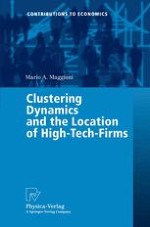2002 | OriginalPaper | Chapter
Conclusion and research agenda
Author : Professor Mario A. Maggioni
Published in: Clustering Dynamics and the Location of High-Tech-Firms
Publisher: Physica-Verlag HD
Included in: Professional Book Archive
Activate our intelligent search to find suitable subject content or patents.
Select sections of text to find matching patents with Artificial Intelligence. powered by
Select sections of text to find additional relevant content using AI-assisted search. powered by
The thesis has looked at the location process of high-tech firms and at the emer-gence of spatial industrial clusters. The main contributions achieved by the work are the following. 1.Clustering (i.e. the spatial concentration of high-tech industries in a given location) is a relevant phenomenon in four major industrialised countries. Clustering is not limited to innovative industries but, in general, these sectors show an above average bias towards spatial concentration. This has been checked with reference to two “benchmark” sectors (Motor vehicles and Textiles) which have been signalled by Krugman (l991a) as two clustered traditional industries.2.The extent of industrial clustering is heavily dependent on the spatial and industrial definitions of the measurement unit. For this reason the statistical analysis has been conducted at two different geographical levels and a careful harmonisation of different national industrial classifications has been performed. Clustering is also heavily influenced by the variable chosen for the analysis. In the thesis both employment and establishments data have been used. Finally, different concentration and inequality indexes may give different results.3.The US appear to have the highest concentration ratio when clustering is measured in term of establishments. If (bearing in mind the usual caveats) one thinks of the US as a similar country to the future monetary and economic European Union, then high-tech clustering seems bound to increase in the next future in Europe.
